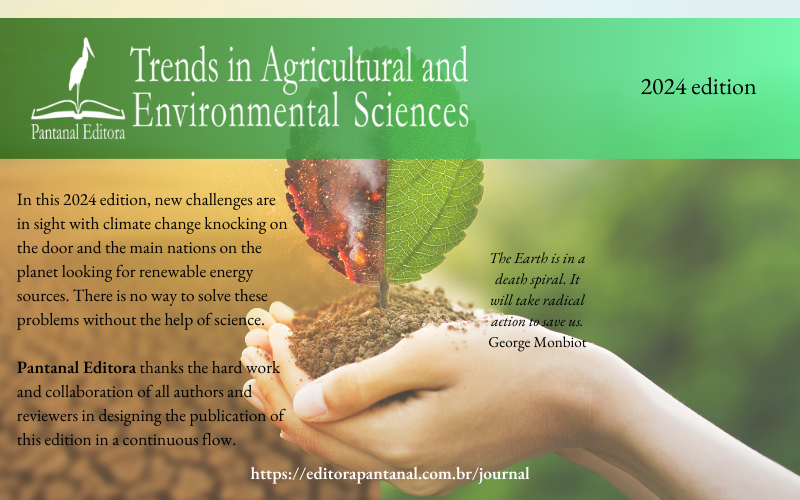Conjunto de dados: Cultivares de feijão-caupi com fertilizantes organominerais residuais do cultivo de milho
DOI:
https://doi.org/10.46420/TAES.e240007Palavras-chave:
Vigna unguiculata (L.) Walp., U. ruziensis, natural phosphates, superphosphateResumo
O feijão-caupi é um alimento básico essencial, especialmente em regiões tropicais e subtropicais, devido ao seu alto teor de proteínas, aminoácidos essenciais e outros nutrientes. Este estudo teve como objetivo avaliar o impacto de fertilizantes organominerais residuais de uma cultura anterior de milho em cultivares de feijão-caupi no sul do Maranhão, Brasil. Duas cultivares de feijão-caupi, BRS Tucumaque e BRS Nova Era, foram avaliadas em delineamento experimental de blocos casualizados com três repetições. Este estudo incorporou dois fertilizantes organominerais derivados de esterco bovino e fosfatos naturais um superfosfato simples na dose de 50 kg ha-1 e uma testemunha sem adubação fosfatada. As principais características agronômicas medidas incluíram o número de nós, vagem por planta, grãos por vagem, peso de mil grãos e rendimento por hectare. Esta investigação sublinha o potencial dos fertilizantes organominerais para aumentar o rendimento do feijão nhemba, ao mesmo tempo que minimiza o impacto ambiental, oferecendo uma alternativa viável aos métodos convencionais de fertilização. Estas conclusões defendem uma adopção mais ampla de fertilizantes organominerais no cultivo do feijão nhemba, aumentando potencialmente o rendimento e reduzindo os custos. A base de dados derivada desta pesquisa é composta por 48 amostras. Foram considerados quatro tipos de adubação: testemunha, superfosfato simples e dois fertilizantes organominerais; dois sistemas de plantio com e sem palha de U. ruziensis; e duas cultivares.
Referências
Barbieri, A.P.P.; Martin, T.N.; Mertz, L.M.; Nunes, U.R.; Conceição, G.M. (2013). Population reduction of wheat for yield and the physiological quality of seeds. Revista Ciência Agronômica, 44(4), 724-731. DOI: 10.1590/S1806-66902013000400008
Coelho, Y.P.; Zuffo, A.M.; Ratke, R.F.; Caldas, A.N.S.; Mezzomo, R.; Barrozo, L.M.; Sousa, C.H.C.; Elsayed, A. Y.A.M.; Fonseca, W.L.; Santos, A.S.; Fontes, L.O. (2023). Physiological quality of soybean seeds as a function of organic-mineral fertilizers. Contribuciones a las Ciencias Sociales, 16, 23632-23650. DOI: 10.55905/revconv.16n.10-292
Concenço, G.; Tomazi, M.; Correia, I.V.T.; Santos, S.A.; Galon, L. 2013. Phytosociological surveys: tools for weedscience? Planta Daninha, 31(2), 469-482. DOI: https://doi.org/10.1590/S0100-83582013000200025
CONAB - Companhia Nacional De Abastecimento. Acompanhamento de safra brasileira: grãos safra 2021/2022 - n. 3 – Terceiro levantamento (2022). Brasília - DF, 99.
Crusciol, C.A.C.; De Campos M.; Martelli, J.M.; Alves, C.J.; Nascimento, C.A.C.; Pereira, J.C. dos R.; Cantarella, H. (2020). Organomineral Fertilizer as Source of P and K for Sugarcane. Scientific Reports, 10, 5398. DOI: 10.1038/s41598-020-62315-1
FAOSTAT. Crops. Available in: http://www.fao.org/faostat/en/#data/QC. Access at: 10 May 2022.
Fernandes, P.H. (2020). Use of phosphate organomineral fertilizers in the cultivation of lettuce and corn in succession. Brazilian Journal of Development, 6(6), 37907-37922. DOI: 10.34117/bjdv6n6-365
Freitas, R.M.O.; Dombroski, J.L.D.; Freitas, F.C.L.; Nogueira, N.V.; Pinto, J.R.S. (2017). Physiological responses of cowpea under water stress and rewatering in no-tillage and conventional tillage systems. Revista Caatinga, 30, 559-567. DOI: 10.1590/1983-21252017v30n303rc
MARANHÃO - GOVERNO DO ESTADO DO MARANHÃO (2002). Gerência de Planejamento e Desenvolvimento Econômico - GEPLAN. Atlas do Maranhão. São Luís: Universidade Estadual do Maranhão, 39.
McKinney, W. (2010). Data structures for statistical computing in Python. In Proceedings of the 9th Python in Science Conference, 445, (1), 51-56.
Passos, M.L.; Zambrzycki, G.C.; Pereira, R.S. (2017). Balanço hídrico climatológico e classificação climática para o município de Balsas-MA. Revista Scientia Agraria, 18(1), 83-89. DOI: 10.5380/rsa.v18i1.48584
Perina, E.F.; Carvalho, C.R.L.; Chiorato, A.F.; Lopes, R.L.T.; Gonçalves, J.G.R.; Carbonell, S.A.M. (2014). Technological quality of common bean grains obtained in different growing seasons. Bragantia, 73, 14-22. DOI: https://doi.org/10.1590/brag.2014.008
Santos, H.G. et al. Sistema brasileiro de classificação de solos, Embrapa, ed. 5, 2018.
Soares, M.B.B.; Bianco, S.; Finoto, E.L.; Bolonhezi, D.; Albuquerque, J.A.A. (2017). Phytosociological study on the weed communities in green sugarcane field reform using conservation tillage and oilseed crops in succession. Applied ecology and environmental research, 15(3), 417-428. DOI: 10.15666/aeer/1503_417428
Vale, J.C; Bertini, C.; Borém, A. (2017). Feijão-caupi: do plantio à colheita. Viçosa, Ed. UFV, 267.
Van Rossum, G., Drake Jr, F. L. (1995). Python tutorial. Centrum voor Wiskunde en Informatica Amsterdam, The Netherlands.
Downloads
Publicado
Edição
Seção
Licença
Copyright (c) 2024 Trends in Agricultural and Environmental Sciences

Este trabalho está licenciado sob uma licença Creative Commons Attribution-NonCommercial-ShareAlike 4.0 International License.
Attribution-NonCommercial-ShareAlike 4.0 International (CC BY-NC-SA 4.0)
You are free to:
- Share — copy and redistribute the material in any medium or format
- Adapt — remix, transform, and build upon the material
The licensor cannot revoke these freedoms as long as you follow the license terms.
Under the following terms:
- Attribution — You must give appropriate credit, provide a link to the license, and indicate if changes were made. You may do so in any reasonable manner, but not in any way that suggests the licensor endorses you or your use.
- NonCommercial — You may not use the material for commercial purposes.
- ShareAlike — If you remix, transform, or build upon the material, you must distribute your contributions under the same license as the original.
- No additional restrictions — You may not apply legal terms or technological measures that legally restrict others from doing anything the license permits.
Notices:
- You do not have to comply with the license for elements of the material in the public domain or where your use is permitted by an applicable exception or limitation.
- No warranties are given. The license may not give you all of the permissions necessary for your intended use. For example, other rights such as publicity, privacy, or moral rights may limit how you use the material.
This is a human-readable summary of (and not a substitute for) the license.






